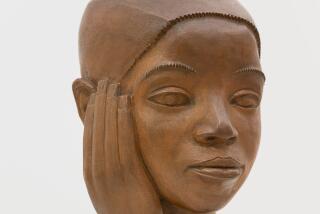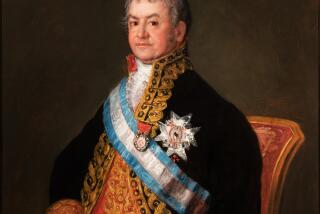Heirlooms From Grandma
Grandma Moses redefined the late bloomer. After decades of farm work, she took up painting in her 70s and captured the hearts of Americans with her nostalgic, folksy reflections of 19th-century rural life.
She was 78 when she was “discovered” by an art collector from New York City, and continued to paint until just a few months before she died in 1961 at age 101. In the intervening years she completed about 1,500 paintings.
Some of the works that have never been exhibited on the West Coast make up the show “Grandma Moses: An American Original,” which opens Saturday at the Ronald Reagan Presidential Library near Simi Valley.
Moses’ paintings are in the collections of many major U.S. art institutions, including the Smithsonian and the Museum of Modern Art in New York. But the largest collection belongs to the Bennington Museum, a private institution in Vermont, about 15 miles from where Moses lived in Eagle Bridge, N.Y.
Deborah Federhen, curator of collections at the Bennington Museum, said the show covers the whole of Moses’ career, from the 1920s effort “In the Adirondacks” to “School,” painted the year she died.
“It was obviously an exhibit that was overdue. She’s such an omnipresent American artist, and we have a monopoly on the largest collection ‘in captivity,’ ” she said with a laugh. The exhibit will be on display through March 15 and then travels to Grand Rapids, Mich., and New Britain, Conn.
Anna Mary Robertson Moses, the artist’s real name, was born in 1860 in Greenwich, N.Y. She grew up, the eldest of 10 children, on her parents’ flax farm and at age 12 went to work as a hired girl. At 27, she married Thomas Salmon Moses and over the years gave birth to 10 children, five of whom survived infancy. In 1905 they bought a dairy farm in Eagle Bridge, N.Y., where she spent the rest of her days.
As her children grew up and she got too old for farm work, Moses returned to the artistic endeavors she had enjoyed as a child. She created “yarn paintings”--three of which are included in this show--a type of embroidery using thick, layered yarn. Arthritis eventually made the needlework difficult, though, and she turned more and more to oil paints for her creative expression.
Moses’ self-taught style--simple figures on a flat landscape--was called naive or primitive, referring to her lack of formal training. Curator Federhen, however, prefers to call it vernacular landscape, which better indicates its connection to 15th- and 16th-century Flemish and Dutch work. Painters such as Pieter Brueghel also created visual vignettes of people engaged in everyday activities. But equally important--if not more so--is the sweeping landscape in the background.
Moses lovingly painted the rolling hills of northern New England on nearly every one of her paintings. The buildings--from the oft-depicted checkered house to the city of Bennington--appear flat. Moses had a large collection of art books and, early on, she copied the art on Currier and Ives prints, Federhen said, so it’s likely that she was familiar with the earlier, European style.
Her fortune hit fairly suddenly. In 1938, Moses was showing her paintings in the drugstore of nearby Hoosick Falls. In 1939, three of her landscapes were included in “Contemporary Unknown Painters,” a show for members of New York’s Museum of Modern Art.
The next year she had a solo show of 35 paintings--”What the Farm Wife Painted”--at the Galerie St. Etienne in New York. That gallery was one of two to sell her paintings exclusively after 1944, and the St. Etienne owners still retain the copyright on each of the images. The Galerie continues to repurchase and sell her work and opened a show of her work in conjunction with the Hammer Gallery this week, said co-director Jane Kallir.
It was her father, Otto Kallir, who masterminded the marketing of Moses and, in a sense, turned her into the prototypic American folk artist. A journalist writing about Moses later that year dubbed her “Grandma,” and magazine articles and traveling exhibitions solidified her fame. In 1949 she received a special award from President Truman. In 1950 she was the subject of a documentary film. In 1952 she published an autobiography.
“She is integral to her art because she has such a wonderful and American story . . . a rebirth of herself when most people are winding down,” said Federhen. Hers is “the classical American story of hard work and endurance and perseverance and making good. That was, in a great sense, what sold her art to the public.”
Otto Kallir showed Moses’ work, among other places, at Gimbels department store, where people who might not stroll into an art gallery would see it. Not surprisingly, Moses was a much bigger hit with the Gimbels crowd than with MOMA’s. Her art was never critically acclaimed in its time.
“Critics said she doesn’t understand perspective, and her figures are stick figures and there are no shadows or shading,” Federhen said. “But on a grass-roots level, she was totally embraced and accepted.”
Among the critics’ cavils: her insistence of putting glitter in the snow on her winter landscapes. She didn’t stop, however, as evidenced by “One Horse Sleigh” (1960), which is in the Reagan Library show.
Early in her career, Moses’ paintings sold for as little as $250. Today works command as much as $70,000. But much of Moses’ fame stemmed from reproductions authorized by Kallir: prints, fabric, wallpaper, tin trays, collectible plates.
Hallmark issued Grandma Moses Christmas cards every winter, starting in 1946. People who might never buy a painting were willing to pay for a calendar or note card.
None of this would have worked, however, if Moses’ homespun images hadn’t touched a national nerve, explained Mark Hunt, director of the Reagan Library. Coming out of the Great Depression, her art tapped into a nostalgia for earlier, better times. Then, in the 1940s, he said, “You see a reaction to industrialization and large, impersonal cities where lots of people were living. At the time her fame started to build, that was part of the mix.”
The rest of the art world, meanwhile, was moving further away from representational painting. After World War II, Abstract Expressionists such as Jackson Pollock and Robert Motherwell relied more on color and form, less on subject matter. Grandma Moses offered America the opposite.
“That’s part of her appeal, I think,” said Federhen. “Her work is very approachable. You don’t feel when you’re looking at her paintings that you have to know a lot about art to understand it, like a Mondrian or other of her contemporaries.”
Will Moses, the great-grandson of Grandma Moses, now lives in her old white farm house in Eagle Bridge. And he, too, is a painter, taught in part by his grandfather, Forrest Moses. His own work is a little more “sharp-edged,” but reminiscent of the primitive folk style that made his last name famous in art circles.
He was about 5 when Grandma Moses died, but he has clear memories of her at work in her makeshift studio off the kitchen.
“We’d stand around and watch her paint. She’d explain what she was doing, what colors she was using, what she was going to put in the painting,” he said.
“I remember the impact of her fame,” he added. “I clearly remember her 100th birthday and all the fuss that was made over that.” Time and Life magazines sent reporters and photographers, as did NBC, he said. “I suppose the family, in one way, was used as props--all posed for a big family photograph.”
Six of Will Moses’ paintings will also be on display at the Reagan library, illustrating the continuation of the folk-art tradition. Both his and Grandma’s work, Will Moses said, continue to be popular, in part, because Americans continue to pine for the good old days.
“It’s art that’s easily understood. There’s not hidden meaning or message. You have the painting--you don’t need an art critic to tell you what you have,” he said. “A simple beauty--that’s pretty much the reason that people enjoy it.”
More to Read
Sign up for The Wild
We’ll help you find the best places to hike, bike and run, as well as the perfect silent spots for meditation and yoga.
You may occasionally receive promotional content from the Los Angeles Times.






